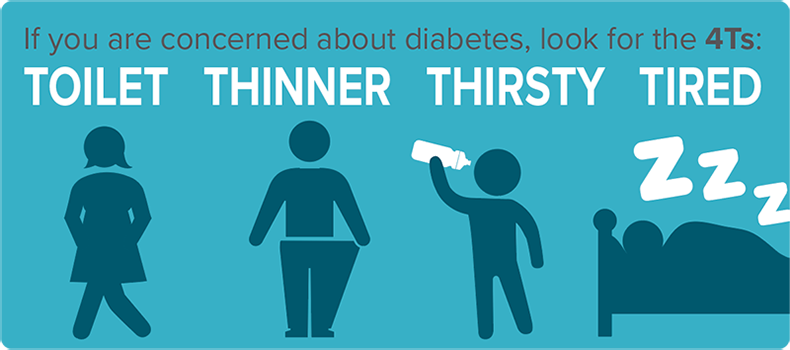What is diabetes?

Diabetes is a chronic disease in which the body has trouble producing insulin, or can’t utilize the insulin it produces effectively. Insulin is a hormone in our bodies that is produced by the pancreas and is used to help regulate blood glucose (blood sugar) levels. Insulin is a hormone responsible for lowering blood glucose, and because of its inhibition caused by diabetes, this leads to elevated blood glucose levels, which is dangerous for many organs throughout the body and general overall health.
There are two different forms of diabetes – type 1 and type 2. Type 1 diabetes is a result of an immune response attacking your own beta cells of the pancreas, thus resulting in the inability to produce insulin, and often manifesting in childhood and adolescence. Type 2 diabetes is a result of not being able to use insulin properly, or making an inadequate amount of it. This often manifested later in life, and is usually a result of poor diet.
What are the symptoms of diabetes?
Aside from prolonged elevated high blood glucose levels, there are a number of other symptoms to keep an eye out for with diabetes. Some of these include:
- Unusual weight change
- Fatigue
- Cuts and bruises that are slow to heal
- Tingling or numbness of the hands and feet
- Unusual thirst and hunger
- Blurry vision
It is important to know that certain predispositions will elevate the likelihood of being diagnosed with diabetes. Some of these predispositions include obesity, being of older age… (should try to find more, if there are any)

How is diabetes managed and treated after diagnosis?
When treating diabetes, the main goals are always to lower blood glucose levels and prevent further complications that can arise. Some of the main strategies to doing so include designing specific diets tailored to individual lifestyles, and moderate amounts of exercise. Additionally, diabetes can be treated by acquiring additional insulin through alternative methods, these methods include oral medications, insulin pumps, insulin injections.
What you can do to reduce your risk?
When talking about preventing diabetes, it is usually preventing type 2 diabetes. Safe and effective ways to prevent type 1 diabetes have not yet been identified, despite the amount of research in this area.
Type 2 diabetes is preventable or at least delayed in many people. Additionally, if you are diagnosed with type 2 diabetes, there are lifestyle modifications that can help reverse, prevent or delay your journey. These include: eating healthy, increasing your activity level, and losing weight if you are overweight.
Eat healthy
The first thing to do is assess your diet and the food choices you are making. Diet is the most important part of lifestyle change. Small changes can make a big difference and help you take those first few steps to reduce your risk.
A good first step is to remove eating highly processed food and refined grains ( white bread, sugary food and sugary drinks). Plan your meals around vegetables, more plant-based proteins, whole grains, dairy, lean meats, oily fish, nuts and healthy oils such as olive oil. Canada’s food guide is an excellent resource to help guide changes. https://food-guide.canada.ca/en/
Diabetes Canada recommends following the DASH diet or Mediterranean diet to help plan healthy meals and snacks for you and your family. A low-carbohydrate version of the Mediterranean diet may have additional cardiovascular benefits for people who are overweight and have type 2 diabetes.
Eating healthy is a good practice for your entire family! Making changes together is helpful and can be motivating.
Get active – move!
Moving more can help you prevent diabetes. Any degree of increased extra activity each day can go a long way.
Limit the amount of time you spend sitting each day. Living with a Spondyloarthritic condition can make mobility and exercise challenging. We encourage you to work with a physiotherapist and/or occupational therapist to learn movements that are encouraged and helpful to SpA patients. If you are very inactive, start by standing up more often and stretching. Maybe add a bit more walking into your routine. Little by little you should see an improvement in what you are able to do. Setting goals can also be helpful. For example, today I am going to talk to the end of my driveway.
For indviduals’ who are more active, set a goal to at least get the recommended l150 minutes of aerobic exercise per week by walking, bicycling, swimming or jogging. Smaller amounts of activity can still have some health benefits.
Lose weight
If you have pre-diabetes, an eating and exercise plan that helps you lose just 5% of your initial body weight can delay or prevent type 2 diabetes from developing. Make an action plan and stick with it. Try not to get discouraged if you don’t see immediate results.
For people with Spondyloarthritic conditions, maintaining a healthy weight can help reduce the stress on joints and improve mobility. This can also impact pain levels.
It can be hard to stay motivated, but reducing your risk of developing diabetes will help you live a longer, healthier life.
Tips to help you
- Start with changing only one thing at a time. It can be overwhelming to try and change too many things at once, and you are less likely to stick with them.
- Set goals that are realistic and doable. Over time any change you make will become part of your everyday routine.
- Make changes with a friend or include your family in new & healthy traditions.
- We all have good days and more challenging days – keep this in mind.
- In addition to helping to manage or prevent diabetes, any changes for the better will help your spondyloarthric conditions.
Where to find additional information and support?
f you have been diagnosed with either type of diabetes, talk to your health-care team or contact Diabetes Canada for information about services and support available in your community. Diabetes Canada has a comprehensive amount of materials and programs across the country. They can be contacted @ www.diabetes.ca
Diabetes Canada is a proud partner in the Canadian Diabetes Prevention Program. The program is a personalized, wellness program with health-care professionals that empowers you to lead a healthier life and may reduce your risk of developing type 2 diabetes.
************************************************************
Content credited to:
Diabetes Canada
Disclaimer: All information is provided for your general knowledge only, and is not a substitute for the advice from, and care by health professionals. Please consult your health care professional regarding details of symptoms, diagnosis and medication or treatment. Any information or links do not imply endorsement by the Canadian Spondylitis Association.